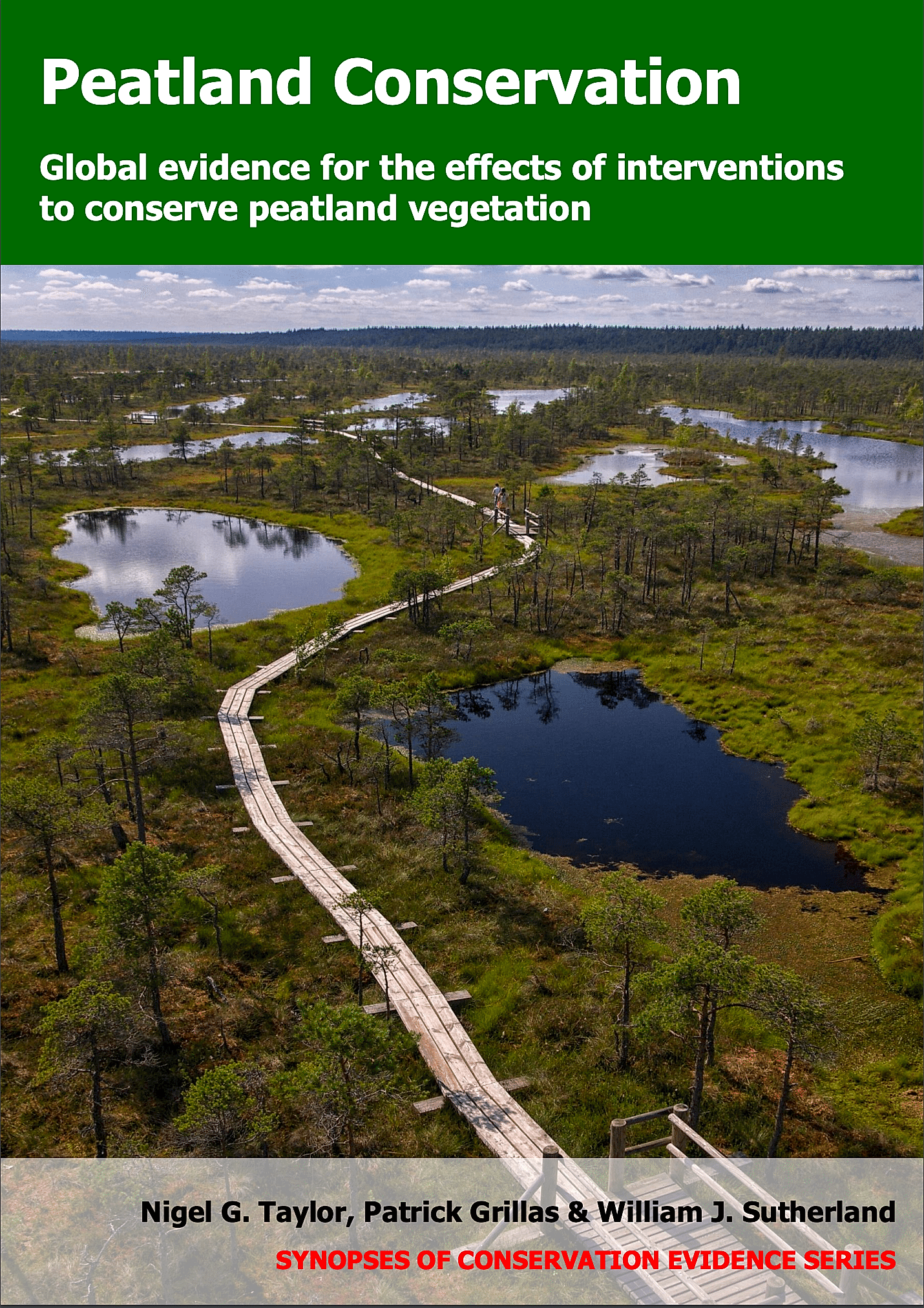Actions to conserve biodiversity
We have summarised evidence from the scientific literature about the effects of actions to conserve wildlife and ecosystems.
Review the evidence from the studies
Not sure what Actions are? Read a brief description.
125 Actions found
Refine
Hide
125 Actions found
Download Actions
Order results by:
| Action | Effectiveness | Studies | Category | |
|---|---|---|---|---|
Physically remove problematic plants Action Link | Unknown effectiveness (limited evidence) | 3 | ||
Divert/replace polluted water source(s) Action Link | Likely to be beneficial | 3 | ||
Fill/block ditches to create conditions suitable for peatland plants (without planting) Action Link | Likely to be beneficial | 3 | ||
Add inorganic fertilizer (without planting) Action Link | Unknown effectiveness (limited evidence) | 3 | ||
Introduce nurse plants (to aid focal peatland plants) Action Link | Unknown effectiveness (limited evidence) | 3 | ||
Create mounds or hollows (before planting) Action Link | Unknown effectiveness (limited evidence) | 3 | ||
Add root-associated fungi to plants (before planting) Action Link | Unknown effectiveness (limited evidence) | 3 | ||
Replace blocks of vegetation after mining or peat extraction Action Link | Unknown effectiveness (limited evidence) | 2 | ||
Remove plant litter to maintain or restore disturbance Action Link | Unknown effectiveness (limited evidence) | 2 | ||
Cut large trees/shrubs to maintain or restore disturbance Action Link | Likely to be beneficial | 2 | ||
Change season/timing of cutting/mowing Action Link | Unknown effectiveness (limited evidence) | 2 | ||
Use cutting to control problematic large trees/shrubs Action Link | Unknown effectiveness (limited evidence) | 2 | ||
Drain/replace acidic water Action Link | Unknown effectiveness (limited evidence) | 2 | ||
Excavate pools (without planting) Action Link | Unknown effectiveness (limited evidence) | 2 | ||
Disturb peatland surface to encourage growth of desirable plants (without planting) Action Link | Unknown effectiveness (limited evidence) | 2 | ||
Cover peatland with organic mulch (without planting) Action Link | Unknown effectiveness (limited evidence) | 2 | ||
Cover peatland with something other than mulch (without planting) Action Link | Unknown effectiveness (limited evidence) | 2 | ||
Provide education or training programmes about peatlands or peatland management Action Link | Unknown effectiveness (limited evidence) | 2 | ||
Lobby, campaign or demonstrate to protect peatlands Action Link | Unknown effectiveness (limited evidence) | 2 | ||
Irrigate peatland (without planting) Action Link | Unknown effectiveness (limited evidence) | 2 | ||
Retain/create habitat corridors in farmed areas Action Link | Unknown effectiveness (limited evidence) | 1 | ||
Reduce intensity of livestock grazing Action Link | Unknown effectiveness (limited evidence) | 1 | ||
Maintain/restore water flow across service corridors Action Link | Unknown effectiveness (limited evidence) | 1 | ||
Reduce intensity of harvest (of wild biological resources) Action Link | Unknown effectiveness (limited evidence) | 1 | ||
Physically exclude vehicles from peatlands Action Link | Unknown effectiveness (limited evidence) | 1 |
Download Actions

Peatland Conservation - Published 2018
Peatland Conservation
Watch this search
If you are familiar with RSS feeds, please click the button below to retrieve the feed URL:
RSS feed for this searchIf you are unfamiliar with RSS feeds, we would suggest reading this BBC article.
Unfortunately, due to the number of feeds we have available, we cannot provide e-mail updates. However, you could use tools such as Feed My Inbox to do this for you.
What are 'Individual studies' and 'Actions'?
Individual studies
An individual study is a summary of a specific scientific study, usually taken from a scientific journal, but also from other resources such as reports. It tells you the background context, the action(s) taken and their consequences.
If you want more detail please look at the original reference.
Actions
Each action page focuses on a particular action you could take to benefit wildlife or ecosystems.
It contains brief (150-200 word) descriptions of relevant studies (context, action(s) taken and their consequences) and one or more key messages.
Key messages show the extent and main conclusions of the available evidence. Using links within key messages, you can look at the paragraphs describing each study to get more detail. Each paragraph allows you to assess the quality of the evidence and how relevant it is to your situation.
Where we found no evidence, we have been unable to assess whether or not an intervention is effective or has any harmful impacts.




















